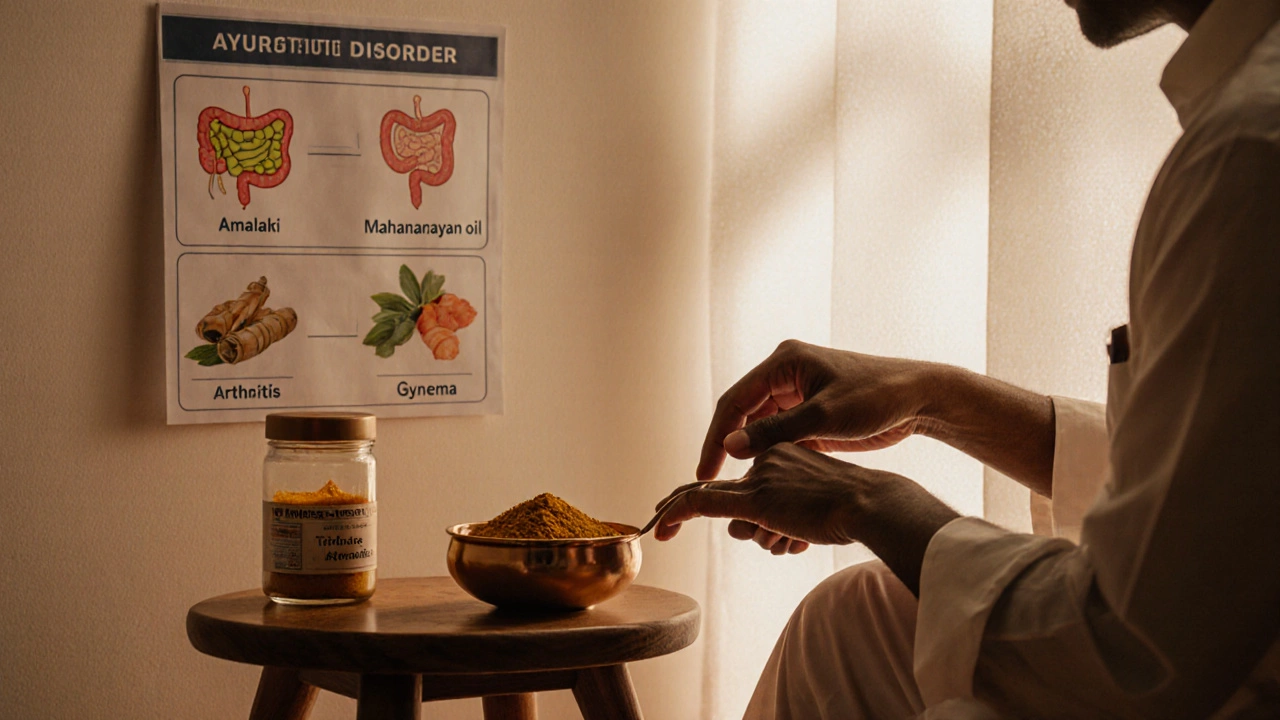Ayurvedic Dosha Assessment Quiz
What's Your Ayurvedic Constitution?
Discover your dominant dosha (Vata, Pitta, or Kapha) based on your natural tendencies, habits, and physical characteristics. This personalized assessment helps you understand which Ayurvedic practices and remedies align best with your unique constitution.
Quick Takeaways
- Ayurveda focuses on balancing the three doshas Vata, Pitta, and Kapha, which govern body functions.
- Common conditions it addresses include digestive disorders, skin issues, respiratory problems, arthritis, and metabolic imbalances.
- Therapies combine diet, herbs (like Turmeric a potent anti‑inflammatory rhizome and Ashwagandha an adaptogenic root that supports stress resilience), lifestyle, and detox procedures.
- Safety hinges on personalized assessment; not every remedy suits every constitution (Prakriti the individual's unique dosha makeup).
- Modern research increasingly backs specific Ayurvedic protocols for chronic inflammation, glycemic control, and mental well‑being.
Understanding the Ayurvedic Framework
When we talk about a Ayurveda cure, we’re really talking about a system that aims to restore harmony rather than just suppress symptoms. The cornerstone is the concept of doshas Vata (air‑water), Pitta (fire‑water), and Kapha (earth‑water). Each person has a unique blend of these energies, called Prakriti the innate constitution determined at birth. Illness is viewed as a dosha imbalance caused by diet, stress, environment, or lifestyle.
Ayurvedic diagnosis begins with pulse reading (nadi pariksha), tongue inspection, and questioning about daily habits. The practitioner then prescribes a tailored plan that may involve dietary changes, specific herbs, yoga, meditation, and cleansing techniques called panchakarma.

Diseases Frequently Managed with Ayurveda
Ayurveda does not claim a universal cure for every modern disease, but centuries of practice have produced robust protocols for several chronic conditions. Below is a non‑exhaustive list of ailments where Ayurvedic care shows measurable benefits.
- Digestive disorders including acid reflux, IBS, and constipation
- Skin problems such as eczema, psoriasis, and acne
- Respiratory conditions like asthma and chronic bronchitis
- Arthritis especially rheumatoid and osteoarthritis
- Metabolic syndrome including type‑2 diabetes and obesity
- Mental stress anxiety, depression, and burnout
- Immune deficiencies frequent infections and low immunity
Each condition aligns with a dominant dosha imbalance, which guides the choice of herbs, diet, and lifestyle tweaks.
How Ayurvedic Treatment Works for Specific Conditions
Below is a practical snapshot of what an Ayurvedic plan might look like for three popular ailments. The emphasis is always on gentle, long‑term correction rather than rapid, pharmaceutical‑style fixes.
| Condition | Dominant Dosha | Key Herbs & Formulas | Diet & Lifestyle Tips |
|---|---|---|---|
| Acid reflux (GERD) | Pitta | Amalaki Amla powder to cool excess fire, Triphala Balances digestion | Avoid hot spices, citrus, and alcohol; eat warm, cooked foods; practice gentle breathing (pranayama) after meals. |
| Rheumatoid arthritis | Vata‑Pitta mix | Turmeric Curcumin reduces inflammation, Mahanarayan oil External massage to ease joint stiffness | Warm oil massages daily; incorporate ginger tea; keep joints warm; avoid cold, raw foods. |
| Type‑2 Diabetes | Kapha (with secondary Vata) | Gymnema sylvestre Helps lower blood sugar, Fenugreek Improves insulin sensitivity | Limit sugars, refined carbs, and dairy; favor bitter greens, legumes, and whole grains; incorporate daily walking or gentle yoga. |
Notice the pattern: each protocol starts with a herb that directly addresses the dosha excess, then adds dietary rules that keep the same dosha in check.

Putting Ayurvedic Care Into Everyday Life
For most readers, the biggest hurdle is translating ancient guidelines into a modern schedule. Here are three actionable habits that work for any constitution.
- Morning oil massage (Abhyanga): Warm sesame or mustard oil, massaged over the whole body for 10minutes, calms Vata and improves circulation. Do it before showering.
- Dosha‑aligned breakfast: Vata types thrive on warm porridges with ghee; Pitta benefits from fresh fruit smoothies with cooling mint; Kapha should start with a light herbal tea and a handful of nuts.
- Evening wind‑down ritual: Dim lights at least an hour before bed, sip warm turmeric‑milk, and practice 5‑minute breathing exercises to settle the mind-especially helpful for stress‑related conditions.
These habits are simple, low‑cost, and backed by both Ayurvedic texts and modern studies on stress reduction and metabolic health.
Safety, Contra‑indications, and When to Seek Conventional Care
Ayurveda is generally safe, but it’s not a free‑for‑all. Herbs can interact with prescription drugs, and aggressive detoxes like Vamana (therapeutic vomiting) are reserved for specific cases.
Key safety tips:
- Always disclose any medications to your Ayurvedic practitioner.
- Pregnant or nursing women should avoid strong purgatives and certain herbs (e.g., Ashwagandha can affect hormone levels at high doses).
- Acute infections or emergencies (heart attack, stroke, severe asthma attack) need immediate conventional treatment; Ayurvedic support can follow once stable.
Integrating both worlds-using Ayurveda for chronic management while relying on allopathic care for acute crises-often yields the best outcomes.
Frequently Asked Questions
Can Ayurveda replace modern medicine?
Ayurveda excels at prevention and long‑term balance, but it isn’t a stand‑alone cure for all emergencies. Using it alongside conventional care usually offers the safest, most comprehensive approach.
How long does it take to see results?
Changes are gradual. Most people notice improved digestion, energy, or sleep within 2-4weeks, while chronic conditions like arthritis may require 3-6months of consistent practice.
Are there any side effects from Ayurvedic herbs?
When taken in recommended doses, side effects are rare. Overuse of strong detox herbs can cause gastrointestinal upset, so professional supervision is essential.
What’s the best way to find a qualified Ayurvedic practitioner?
Look for practitioners with formal training from recognized Ayurvedic colleges, membership in professional bodies, and transparent patient reviews.
Can I use Ayurvedic remedies at home without a doctor?
Simple dietary tweaks, daily oil massage, and basic herbs like turmeric are safe for most people. For targeted formulas or detox programs, consult a qualified teacher first.
